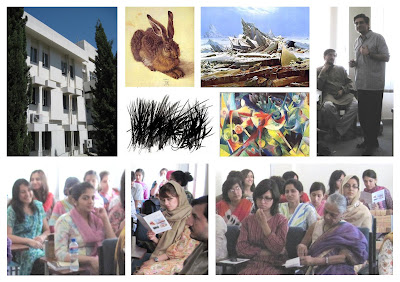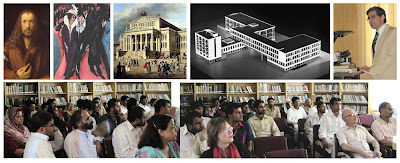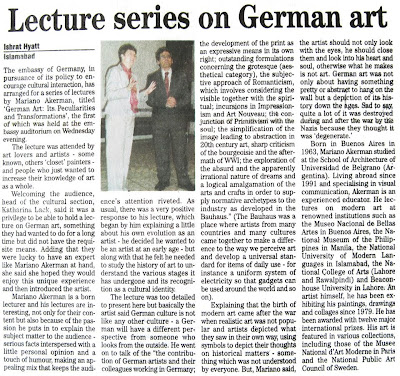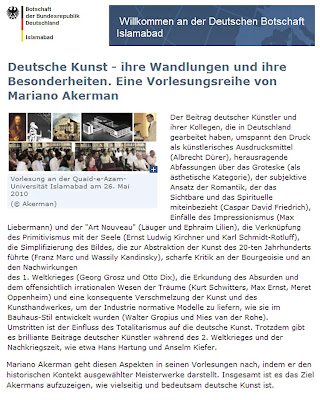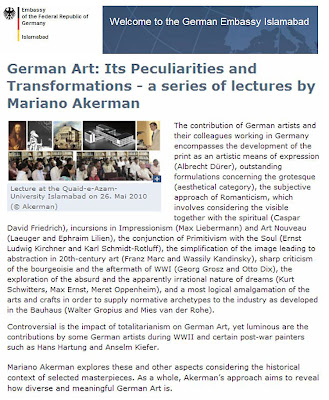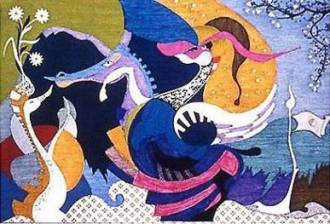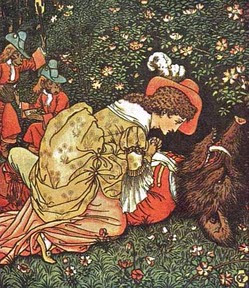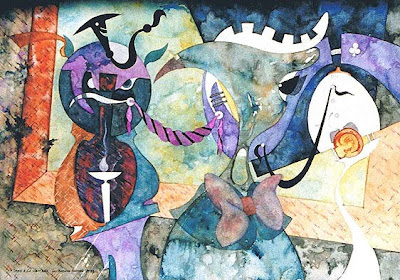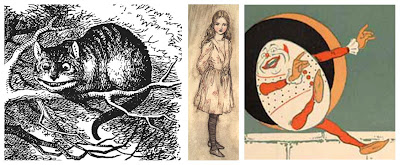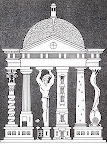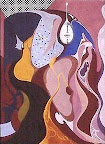
"Pak-German visual arts discussed," Daily Times, Pakistan, 27.5.2010
ISLAMABAD: One-day seminar under the auspices of Quaid-i-Azam University’s (QAU) National Institute of Pakistan Studies (NIPS) [and the German Embassy in Islamabad] was held here on Wednesday.
[...] Argentinean painter and art historian Mariano Akerman presented pictorial images of [...] German architecture, art and d[esign] at the seminar titled ‘Pak-German Visual Arts’. [Corrigendum. "The German Contribution to the Modern Visual Arts, 1500-1933," as the brochure states, while Pakistani were of course most of the participants].
[Surprisingly, this note says nothing about the twenty artworks by German creators discussed by Mariano Akerman during the presentation. Nor does the note explain anything about the lecturer's approach, which was highly prized by an audience listening to him attentively during some 75 or 80 minutes and under the steady pressure of 44°C in Islamabad that day].
Speaking on the occasion, Akerman said [among very many other things] that much of western modern art and architecture was [partly] inspired by [...] German [design]. “In fact, [modern design ...] has [some of] its [main] roots in [...] German art and architecture,” he added.
Participants of the seminar mostly students and professors pointed out [as a matter of fact discovered] common features between the Pakistani and German architecture [and industrial design]. [... They] were also [... concerned with] the resistance [some of] the German artists offered to the totalitarian regime of Hitler. [Neither Nazi propaganda nor its impact on German history were discussed during Akerman's presentation, yet the lecturer shared some of his knowledge on the topic when asked about them. But Akerman also spoke of the achievements of those artists the Nazis branded as "degenerate, inferior and undesirable" and even referred to the postwar decades of oblivion and remembrance. After the lecture, some of the participants approached the lecturer and warmly thanked him for "bridging cultures"].
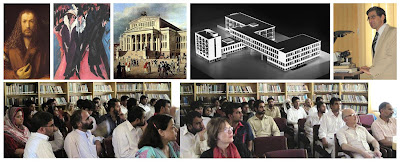
The German Contribution to the Modern Visual Arts, 1500-1933
Quaid-i-Azam University, Islambad
May 26th, 2010
90 minutes
45 participants
Artists and architects whose work was discussed by Mariano Akerman during the event: Albrecht Dürer, Johann Heinrich Keller, Karl Friedrich Schinkel, Caspar David Friedrich, Karl Eduard Biermann, Max Liebermann, Max Laueger, Ephraim Moses Lilien, Ernst Ludwig Kirchner, Karl Schmidt-Rottluff, Franz Marc, Wassily Kandinsky, Kurt Schwitters, Max Ernst, Meret Oppenheim, Walter Gropius, Marcel Breuer, Ludwig Mies van der Rohe.
The activity at Quaid-i-Azam University is part of Akerman's series of lectures on German Art, which are developed in Pakistan thanks to the support of the German Embassy in Islamabad. See also "German Art" (5.5.2010) and "Lecture Series on German Art" (14.5.2010).
ISLAMABAD: One-day seminar under the auspices of Quaid-i-Azam University’s (QAU) National Institute of Pakistan Studies (NIPS) [and the German Embassy in Islamabad] was held here on Wednesday.
[...] Argentinean painter and art historian Mariano Akerman presented pictorial images of [...] German architecture, art and d[esign] at the seminar titled ‘Pak-German Visual Arts’. [Corrigendum. "The German Contribution to the Modern Visual Arts, 1500-1933," as the brochure states, while Pakistani were of course most of the participants].
[Surprisingly, this note says nothing about the twenty artworks by German creators discussed by Mariano Akerman during the presentation. Nor does the note explain anything about the lecturer's approach, which was highly prized by an audience listening to him attentively during some 75 or 80 minutes and under the steady pressure of 44°C in Islamabad that day].
Speaking on the occasion, Akerman said [among very many other things] that much of western modern art and architecture was [partly] inspired by [...] German [design]. “In fact, [modern design ...] has [some of] its [main] roots in [...] German art and architecture,” he added.
Participants of the seminar mostly students and professors pointed out [as a matter of fact discovered] common features between the Pakistani and German architecture [and industrial design]. [... They] were also [... concerned with] the resistance [some of] the German artists offered to the totalitarian regime of Hitler. [Neither Nazi propaganda nor its impact on German history were discussed during Akerman's presentation, yet the lecturer shared some of his knowledge on the topic when asked about them. But Akerman also spoke of the achievements of those artists the Nazis branded as "degenerate, inferior and undesirable" and even referred to the postwar decades of oblivion and remembrance. After the lecture, some of the participants approached the lecturer and warmly thanked him for "bridging cultures"].

The German Contribution to the Modern Visual Arts, 1500-1933
Quaid-i-Azam University, Islambad
May 26th, 2010
90 minutes
45 participants
Artists and architects whose work was discussed by Mariano Akerman during the event: Albrecht Dürer, Johann Heinrich Keller, Karl Friedrich Schinkel, Caspar David Friedrich, Karl Eduard Biermann, Max Liebermann, Max Laueger, Ephraim Moses Lilien, Ernst Ludwig Kirchner, Karl Schmidt-Rottluff, Franz Marc, Wassily Kandinsky, Kurt Schwitters, Max Ernst, Meret Oppenheim, Walter Gropius, Marcel Breuer, Ludwig Mies van der Rohe.
The activity at Quaid-i-Azam University is part of Akerman's series of lectures on German Art, which are developed in Pakistan thanks to the support of the German Embassy in Islamabad. See also "German Art" (5.5.2010) and "Lecture Series on German Art" (14.5.2010).



